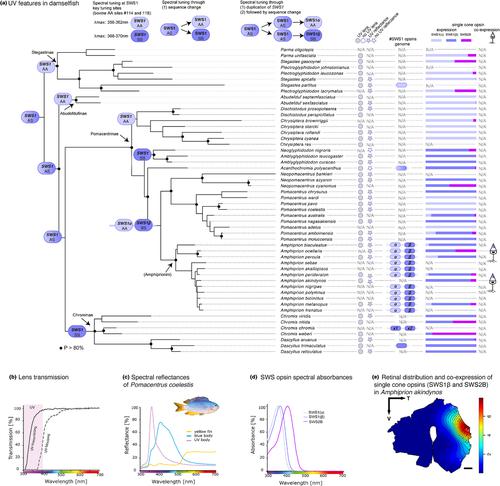当前位置:
X-MOL 学术
›
Ecol. Evol.
›
论文详情
Our official English website, www.x-mol.net, welcomes your feedback! (Note: you will need to create a separate account there.)
Short‐wavelength‐sensitive 1 (SWS1) opsin gene duplications and parallel visual pigment tuning support ultraviolet communication in damselfishes (Pomacentridae)
Ecology and Evolution ( IF 2.6 ) Pub Date : 2024-04-16 , DOI: 10.1002/ece3.11186 Sara M. Stieb 1, 2, 3 , Fabio Cortesi 3, 4 , Laurie Mitchell 3, 5 , Luiz Jardim de Queiroz 1, 2 , N. Justin Marshall 3 , Ole Seehausen 1, 2
Ecology and Evolution ( IF 2.6 ) Pub Date : 2024-04-16 , DOI: 10.1002/ece3.11186 Sara M. Stieb 1, 2, 3 , Fabio Cortesi 3, 4 , Laurie Mitchell 3, 5 , Luiz Jardim de Queiroz 1, 2 , N. Justin Marshall 3 , Ole Seehausen 1, 2
Affiliation

|
Damselfishes (Pomacentridae) are one of the most behaviourally diverse, colourful and species‐rich reef fish families. One remarkable characteristic of damselfishes is their communication in ultraviolet (UV) light. Not only are they sensitive to UV, they are also prone to have UV‐reflective colours and patterns enabling social signalling. Using more than 50 species, we aimed to uncover the evolutionary history of UV colour and UV vision in damselfishes. All damselfishes had UV‐transmitting lenses, expressed the UV‐sensitive SWS1 opsin gene, and most displayed UV‐reflective patterns and colours. We find evidence for several tuning events across the radiation, and while SWS1 gene duplications are generally very rare among teleosts, our phylogenetic reconstructions uncovered two independent duplication events: one close to the base of the most species‐rich clade in the subfamily Pomacentrinae, and one in a single Chromis species. Using amino acid comparisons, we found that known spectral tuning sites were altered several times in parallel across the damselfish radiation (through sequence change and duplication followed by sequence change), causing repeated shifts in peak spectral absorbance of around 10 nm. Pomacentrinae damselfishes expressed either one or both copies of SWS1 , likely to further finetune UV‐signal detection and differentiation. This highly advanced and modified UV vision among damselfishes, in particular the duplication of SWS1 among Pomacentrinae, might be seen as a key evolutionary innovation that facilitated the evolution of the exuberant variety of UV‐reflectance traits and the diversification of this coral reef fish lineage.
中文翻译:

短波长敏感 1 (SWS1) 视蛋白基因复制和平行视色素调节支持雀鲷 (Pomacentridae) 的紫外线通讯
雀鲷(Pomacentridae)是行为最多样化、色彩最丰富、物种最丰富的珊瑚鱼科之一。雀鲷的一项显着特征是它们利用紫外线 (UV) 进行交流。它们不仅对紫外线敏感,而且还容易具有反射紫外线的颜色和图案,从而发出社交信号。我们利用 50 多个物种,旨在揭示雀鲷的紫外线颜色和紫外线视觉的进化历史。所有雀鲷都有可透过紫外线的晶状体,表示对紫外线敏感SWS1 视蛋白基因,大多数显示出紫外线反射图案和颜色。我们发现了辐射中几个调谐事件的证据,同时SWS1 基因重复在硬骨鱼中通常非常罕见,我们的系统发育重建发现了两个独立的重复事件:一个接近于 Pomacentrinae 亚科中物种最丰富的分支的基础,另一个发生在单个 Chromis 物种中。通过氨基酸比较,我们发现已知的光谱调谐位点在雀鲷辐射中平行改变了几次(通过序列改变和重复,然后是序列改变),导致峰值光谱吸光度重复变化约 10 nm。 Pomacentrinae 雀鲷表达一个或两个拷贝SWS1 ,可能会进一步微调紫外线信号检测和区分。雀鲷的这种高度先进和改良的紫外线视觉,特别是复制SWS1 在 Pomacentrinae 中,可能被视为一项关键的进化创新,促进了丰富多样的紫外线反射特征的进化和珊瑚礁鱼类谱系的多样化。
更新日期:2024-04-16
中文翻译:

短波长敏感 1 (SWS1) 视蛋白基因复制和平行视色素调节支持雀鲷 (Pomacentridae) 的紫外线通讯
雀鲷(Pomacentridae)是行为最多样化、色彩最丰富、物种最丰富的珊瑚鱼科之一。雀鲷的一项显着特征是它们利用紫外线 (UV) 进行交流。它们不仅对紫外线敏感,而且还容易具有反射紫外线的颜色和图案,从而发出社交信号。我们利用 50 多个物种,旨在揭示雀鲷的紫外线颜色和紫外线视觉的进化历史。所有雀鲷都有可透过紫外线的晶状体,表示对紫外线敏感



























 京公网安备 11010802027423号
京公网安备 11010802027423号